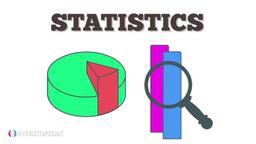
Inferential Statistics
Quiz by Amie Harris
Feel free to use or edit a copy
includes Teacher and Student dashboards
Measure skillsfrom any curriculum
Measure skills
from any curriculum
Tag the questions with any skills you have. Your dashboard will track each student's mastery of each skill.
With a free account, teachers can
- edit the questions
- save a copy for later
- start a class game
- automatically assign follow-up activities based on students’ scores
- assign as homework
- share a link with colleagues
- print as a bubble sheet
22 questions
Show answers
- Q1If I carried out a study using an unrelated measures design and nominal data, which statistical test would I use?WilcoxonMann WhitneyChi squareSign Test30s
- Q2If I carried out a study were I used a correlation and both co-variables collected interval data, which statistical test would I use?PearsonsBinomialWilcoxonMann Whitney30s
- Q3If I calculated an observed value of 3.22 and found a critical value of 4.89 for a Chi-Square test. Would it be significant or not?significantnot significant30s
- Q4How is degrees of freedom calculated for Chi-squarenumber of participants - 1(number of rows - 1) x (number of columns -1)(number of rows - 1) + (number of columns -1)30s
- Q5If I calculated an observed value of 6.62 and found a critical value of 3.34 for a Wilcoxon test. Would it be significant or not?significantnot significant30s
- Q6If I calculated an observed value of 7.98 and found a critical value of 7.66 for a Spearman's rho test. Would it be significant or not?not significantsignificant30s
- Q7How do you find the critical value for Mann Whitney Uyou calculate degrees of freedomnumber of participants - 1you find the number of differences between conditionsnumber of participants for each condition30s
- Q8How do you find the CRITICAL value for a Sign test?you find the total number of participantsyou calculate degrees of freedomyou find the number of participants that show a difference (ignore ppts with no difference)30s
- Q9Which test am I? I test for a difference between two sets of scores. I am used where data is interval and I am used where the data is unrelated.WilcoxonPearson's rUnrelated t testRelated t test30s
- Q10Which test am I? I am a test for the difference between two sets of scores. I am used where data is interval and I am used where the data is related.Pearson's rRelated t testSpearman's rhoChi-square30s
- Q11Which test am I? I use a correlational design, I look for a relationship and I collect interval data for each co-variable.Pearson's rUnrelated t testMann WhitneySign test30s
- Q12Which test am I? I look for a difference between sets of scores. I collect ordinal data and I use a repeated measures design.Chi-squareWilcoxonSign testUnrelated t test30s
- Q13Which test am I? I collect nominal data, I look for a difference and I use an unrelated design.Sign TestChi-squareSpearmansPearson's r30s
- Q14Students want to investigate the correlation between happiness scores and how many friends people have on Facebook. Identify the correct statistical testRelated t testSpearman's rhoWilcoxonSign test30s
- Q15A researcher wants to investigate whether reaction times increase after a person is given a dose of caffeine equivalent to three cups of coffee. The participant’s base reaction times are compared with those 30 minutes after the caffeine intake. Identify the correct statistical test.Related t testChi-squareMann WhitneyUnrelated t test30s